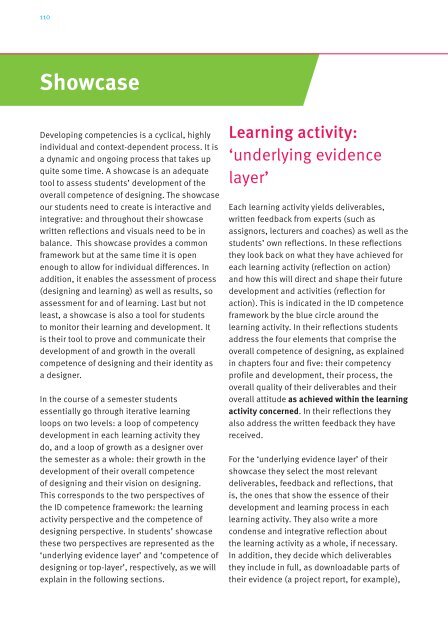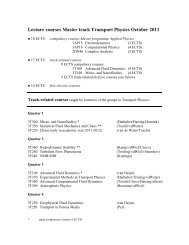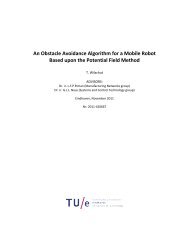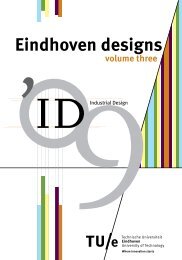Education guide 'Eindhoven designs' - Technische Universiteit ...
Education guide 'Eindhoven designs' - Technische Universiteit ...
Education guide 'Eindhoven designs' - Technische Universiteit ...
Create successful ePaper yourself
Turn your PDF publications into a flip-book with our unique Google optimized e-Paper software.
110<br />
Showcase<br />
Developing competencies is a cyclical, highly<br />
individual and context-dependent process. It is<br />
a dynamic and ongoing process that takes up<br />
quite some time. A showcase is an adequate<br />
tool to assess students’ development of the<br />
overall competence of designing. The showcase<br />
our students need to create is interactive and<br />
integrative: and throughout their showcase<br />
written reflections and visuals need to be in<br />
balance. This showcase provides a common<br />
framework but at the same time it is open<br />
enough to allow for individual differences. In<br />
addition, it enables the assessment of process<br />
(designing and learning) as well as results, so<br />
assessment for and of learning. Last but not<br />
least, a showcase is also a tool for students<br />
to monitor their learning and development. It<br />
is their tool to prove and communicate their<br />
development of and growth in the overall<br />
competence of designing and their identity as<br />
a designer.<br />
In the course of a semester students<br />
essentially go through iterative learning<br />
loops on two levels: a loop of competency<br />
development in each learning activity they<br />
do, and a loop of growth as a designer over<br />
the semester as a whole: their growth in the<br />
development of their overall competence<br />
of designing and their vision on designing.<br />
This corresponds to the two perspectives of<br />
the ID competence framework: the learning<br />
activity perspective and the competence of<br />
designing perspective. In students’ showcase<br />
these two perspectives are represented as the<br />
‘underlying evidence layer’ and ‘competence of<br />
designing or top-layer’, respectively, as we will<br />
explain in the following sections.<br />
Learning activity:<br />
‘underlying evidence<br />
layer’<br />
Each learning activity yields deliverables,<br />
written feedback from experts (such as<br />
assignors, lecturers and coaches) as well as the<br />
students’ own reflections. In these reflections<br />
they look back on what they have achieved for<br />
each learning activity (reflection on action)<br />
and how this will direct and shape their future<br />
development and activities (reflection for<br />
action). This is indicated in the ID competence<br />
framework by the blue circle around the<br />
learning activity. In their reflections students<br />
address the four elements that comprise the<br />
overall competence of designing, as explained<br />
in chapters four and five: their competency<br />
profile and development, their process, the<br />
overall quality of their deliverables and their<br />
overall attitude as achieved within the learning<br />
activity concerned. In their reflections they<br />
also address the written feedback they have<br />
received.<br />
For the ‘underlying evidence layer’ of their<br />
showcase they select the most relevant<br />
deliverables, feedback and reflections, that<br />
is, the ones that show the essence of their<br />
development and learning process in each<br />
learning activity. They also write a more<br />
condense and integrative reflection about<br />
the learning activity as a whole, if necessary.<br />
In addition, they decide which deliverables<br />
they include in full, as downloadable parts of<br />
their evidence (a project report, for example),

















